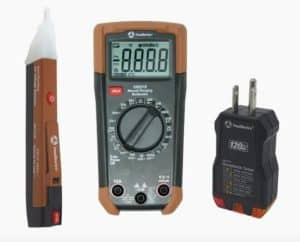Don’t use a NCVT on a 12-Volt fuse….
A Non-Contact Voltage Tester only works on AC voltage! Learn how your testers work...
Dear Readers,
Last week there was a reader on my RVelectricity Facebook Group who was having all sorts of electrical problems with his RV, including air conditioners tripping the circuit breaker on the pedestal, 3-way refrigerator not running, and a bunch of inside electrical outlets that didn’t have power.
We eventually found that the 50-amp circuit breaker in the campground pedestal was arcing internally, causing it to overheat. But as I was assisting with troubleshooting, I found that the reader was using a few test tools incorrectly, causing much confusion and adding days to hom sorting out the reason for the failure.
Rule #1: Always test your testers….
The first problem was caused by using a 12-volt circuit tester to check the fuses. Normally this would be a useful test. However, the reader didn’t realize that the bulb in the tester was burned out. So even though the fuses were good, he thought they were all bad. So he was pulling out all the fuses and swapping them around.
What are the chances?
Of course, the possibility of all fuses burning out at the same time is pretty remote. And swapping unknown fuses around only causes more confusion and compounds the errors. So the first rule is to always confirm that your tester is actually working. In this case it’s as simple as putting this tester across your RV battery terminals. If it lights up, then you know the tester is working and the battery has at least some charge on it. If it’s not working and other lights in your RV are on, then your tester has failed, probably due to a burned out bulb in the earlier testers. Modern voltage testers generally use LED bulbs so they should never fail. However, you should still test all testers for proper operation first.
Don’t use a Non-Contact Voltage Tester on 12-volt DC circuits
Next up, my reader attempted to use a Non-Contact Voltage Tester to check the fuses in circuit. Of course, that showed no voltage anywhere, causing even more troubleshooting confusion. And that’s because an NCVT can’t detect DC voltage, it only works on AC voltage.
For review, HERE is one of my articles with a video on proper use of a Non-Contact Voltage Tester.
Since these testers work by listening for 60-Hz hum, and there’s no hum in a DC circuit, then they register nothing on a 12-volt DC fuse. So they only work on AC circuits.
Check your tester on a live voltage first
Again, always check your tester first on a circuit that you know is live. So, turn on the NCVT and see that it beeps and lights up normally in active mode. Then point it close to an outlet on the pedestal that’s powered up. You may have to poke it into the hot slot on the outlet if you’re using 90 to 1,000-volt NCVT. But if your tester doesn’t work on a known-live circuit, then the tester has failed, probably due to a dead battery. And remember, these are for testing 120-volt AC circuits only, not 12-volt DC circuitd.
When you hear hoofbeats, think horses, not zebras…
The most important rule for troubleshooting any sort of failure is to look for the simplest thing to be failing. In the above example, the possibility of every single fuse in a load center blowing simultaneously is very remote.
Same for the 120-volt AC side of the panel. If you have no AC power anywhere in the RV, then it’s extremely unlikely that every circuit breaker has failed at the same time. So look upstream at the Automatic Transfer Switch or shore power twist-lock connector or the campground pedestal circuit breaker.
The key thing to do is to observe the failure and look for the simplest explanation. Multiple failures at the same time are possible, but unlikely. Always test your testers first to make sure you don’t go down the rabbit hole with incorrect data. And never swap unknown components around without a specific plan in place.
Always know how your testers work
Don’t buy a meter or tester of any sort and just throw it in the drawer for the next time you need it. Take out the manual and read up on basic operation. Always try it out on a few operating circuits so you know what to expect.
And if it requires batteries, make sure you have a backup battery in your road kit, just in case. There are few things more frustrating than trying to troubleshoot an electrical failure while camped out in the middle of nowhere and your meter or NCVT has a dead battery.
Let’s play safe out there…. Mike











Thanks Mike some really great common since advice!
The unknown dead tester battery! Not too long ago I was checking my Jeep battery as it had sat for about 3 weeks since it ran. I actually have 3 digital meters, (lucky me} One in the RV one in the shop & one in my desk drawer. So while checking the Jeep with the garage meter, it read 12.2 VDC, as I was viewing the voltage it started to increase, slowly till it got to 15.5 VDC. Checked the setting & was set @20VDC. Got the motor home one & now i get a constant 12.2 VDC. Hmmm, my shop meter must have checked too many circuits. Then the light bulb went on, maybe the 9V battery in the meter was depleted! Took out the battery & checked with MH meter & yup it showed 8.8 VDC. New (tested) battery fixed the problem. So if your digital meter is doing weird stuff, might just test its battery!
Snoopy
Thought this experience might help others. We have a Winnebago Travato and recently a number of the 110 volt plugs died. No circuit breaker blown, what the ....After numerous dead ends, turned out that somehow water from the fresh water tank had splashed onto an adjacent 110 plug which was a GFI recepticle. The kicker was that 2 other receptacles were on the same circuit and wired to be protected by the GFI that had tripped. I really thought I had lost my mind, or at least my electrical understanding mind.